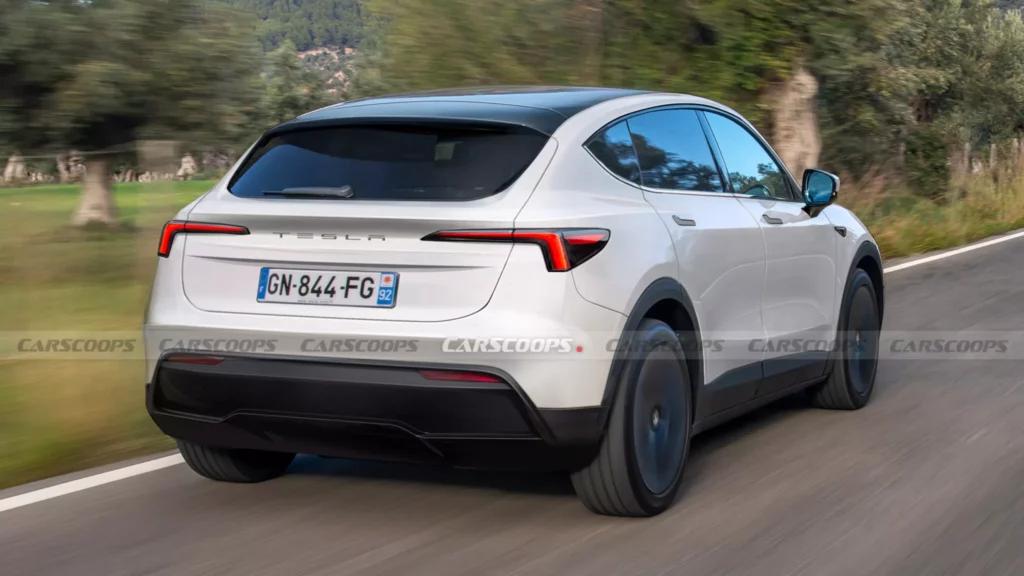The electric vehicle industry is abuzz with Tesla’s latest news from their meeting at Deutsche Bank’s Autonomous Driving Day in New York. The discussions, led by Tesla’s Head of Investor Relations, Travis Axelrod, focused on significant plans for 2025, including a more affordable electric vehicle and expansions in the Chinese market. These developments suggest Tesla’s strategic pivot towards affordability and market expansion, promising a dynamic year for the company and its stakeholders.
Introducing Tesla’s Affordable Model Q
Highlighting the discussions was the potential release of a new, budget-friendly electric vehicle, tentatively labeled the “Model Q.” This entry-level EV is set to debut in early 2025 and might be priced under $30,000 with subsidies, or around $37,499 without. It’s a strategic move aimed at making Tesla’s advanced technology more accessible to a broader audience.
 Tesla's Model Q render showcasing a compact design
Tesla's Model Q render showcasing a compact design
Elon Musk, while historically cautious about low-cost models due to profitability challenges, seems to have found a feasible balance. The Model Q promises to deliver value without compromising on quality, which fits into Musk’s strategic vision, despite his earlier remarks about the viability of low-cost models.
Expansion into China with a Stretched Model Y
Tesla is also setting its sights on the Chinese market with a longer, three-row version of the Model Y. This variant aims to cater to the demands of Chinese families who prefer larger vehicles. The extended Model Y is strategically designed to compete with local manufacturers, offering more space while maintaining Tesla’s renowned performance and technology stack.
 Speculative rendering of the 2026 Tesla Model Y Juniper
Speculative rendering of the 2026 Tesla Model Y Juniper
A “Juniper” codenamed refresh is in the works, enhancing the vehicle with new features without diverging too far from its successful formula. This aligns with Tesla’s focus on expanding its market reach, particularly in regions where larger vehicles are in demand.
Navigating Challenges and Strategic Growth
The Deutsche Bank report also outlines Tesla’s broader strategy for 2025, emphasizing the balancing act of product launches and profitability. The introduction of new models often leads to short-term disruptions due to initial production inefficiencies. However, this can be counterbalanced by the reduced cost of goods from newer, more affordable models.
Tesla’s ambition doesn’t stop at affordable pricing. Management plans to scale production efficiently while exploring new markets, possibly through its Mexico plant, contingent on geopolitical developments and tariff policies. The company aims to maintain a steady growth trajectory of 20-30% in volume in 2025, positioning itself as a leader in innovation and sustainability.
The Road Ahead
As 2025 approaches, Tesla faces both opportunities and uncertainties. A key factor in its success will likely be policy decisions in the United States, particularly regarding tax credits vital for the electric vehicle market. These decisions could significantly impact sales and growth, as seen in Germany where subsidy cuts led to sales declines.
While the path forward is fraught with challenges, Tesla’s roadmap projects a year of transformative growth and adaptation. By focusing on affordable pricing, market expansion, and sustained innovation, Tesla aims to not only maintain its competitive edge but also contribute to a sustainable automotive future.
 Tesla's strategic vision represented by a futuristic concept vehicle
Tesla's strategic vision represented by a futuristic concept vehicle
As Tesla navigates 2025 and beyond, it remains an industry pioneer, continually pushing the boundaries of technology, design, and environmental responsibility. The upcoming years will prove pivotal in shaping the future of electric vehicles worldwide.









